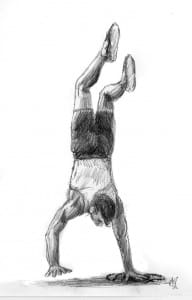The Martyr Who Walked On His Hands
By LORRAINE V. MURRAY, Commentary | Published June 20, 2013
It was a sizzling evening in Jacksonville about six years ago. My husband and I had just come out of a restaurant where we’d had supper with my nephew and his wife, plus their two sons and a daughter.
Outside, we experienced a lovely moment of grace—and a reminder of God’s generosity—when we glimpsed a double rainbow in the turquoise sky. Soon after, we all headed to a nearby ice-cream shop for dessert, and I will always remember how the middle child, Braden—who had training as a gymnast and dancer—surprised us by walking on his hands.
Recently, this memory was revived when Msgr. Richard Lopez handed me a simple prayer card showing a black-and-white photo of a handsome young man. He is Blessed Alois Andritzki, a priest and martyr who lived a Christ-centered existence until the last moments of his life. His memorial, July 2, will soon be upon us.
Father Andritzki was born on July 2, 1914, in Dresden, Germany, into a family of six boys, three of whom became priests. He was ordained in 1939, about a month before the start of World War II, and was arrested by the Nazi secret police in 1941 for openly defending people’s freedom to practice their faith. He was imprisoned at the Dachau concentration camp.
In a book called “Christ in Dachau,” Father Lenz, a survivor of the camp, reveals that there were about 2,400 Catholic priests detained at Dachau. Father Lenz describes Father Andritzki as maintaining his serenity in the midst of the camp’s horrors—and doing whatever he could to help others endure the hardships.
 It seems that Father Andritzki had training as an acrobat, and, like my nephew, he was able to perform the difficult feat of walking upon his hands. And in the days before hunger and illness severely weakened him, he used his talents to bring a glimmer of light to the dark hell known as Dachau. A talented artist, he also painted a Nativity scene on the barracks’ walls.
It seems that Father Andritzki had training as an acrobat, and, like my nephew, he was able to perform the difficult feat of walking upon his hands. And in the days before hunger and illness severely weakened him, he used his talents to bring a glimmer of light to the dark hell known as Dachau. A talented artist, he also painted a Nativity scene on the barracks’ walls.
About two years after his imprisonment, he fell ill from typhoid and was in great agony. At one point, when he mentioned his longing for Holy Communion, the Nazi warden jeered at him: “He wants Christ. We’ll give him an injection instead.” And so this heroic priest died as a result of lethal injection at the age of 28.
In 2010, Pope Benedict XVI declared him venerable by a decree of martyrdom and then beatified him at the Dresden Cathedral on June 11 of the following year.
On the back of the holy card there is a lovely prayer, asking for the intercession of Blessed Alois Andritzki, “so that I may never be the slave of any unfortunate circumstances in my life.” The holy card remains on my desk, a little remembrance of a man I never met, a man who died long ago, and who lives on in the heart of Jesus Christ.
When I look at the serene face depicted on the holy card, I recall that day in Florida when I watched a little boy walking on his hands. We were all so happy that day, and why not? We were well fed, we were enjoying each other’s company and we were free to practice our religion. In such circumstances, it is not difficult to bear joyful witness to Christ.
But the story about this heroic priest is a poignant reminder that many who love Christ have died in prisons and endured terrible martyrdom rather than turning their backs on him. The story beckons us to hold fast to Christ and pray for the grace to keep our serenity, no matter what the future may bring.




